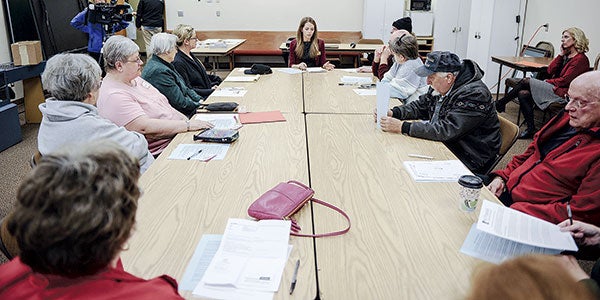Older Minnesotans Paying a Heavy Price; For Essential, Even Life-saving Prescription Drugs
Published 10:06 am Friday, April 8, 2016

Seniors sat down with Sam Mills, center, and other members of Sen. Al Franken’s office last month at the Mower County Senior Center to discuss prescription drug costs. Herald file photos
By Al Franken
U.S. Senator, Minnesota
At a recent meeting in Austin, some older Minnesotans shared stories that they should never have to tell.
Like millions of other Americans, these seniors feel powerless as their health and financial well-being is often jeopardized by ever-rising prescription drug prices. Recent double-digit increases — far beyond the U.S. inflation rate — are putting essential, even life-saving, medicines out of reach for too many people.
In short, many budget-strapped seniors are being forced to choose between buying doctor-prescribed medications and paying for other basic necessities like food, rent, or gas. For some, it means cutting their pills in half to make them last longer, or even taking the risk of forgoing their medications altogether.
At the Austin meeting, a local woman shared that the price of her medications have risen so much that she’s had to cut back on groceries and had to skip buying presents for her children and grandchildren. It was really hard for her over the holidays.
Her story was gathered as part a “Prescription Drug Cost Listening Tour” that my office conducted throughout the state to hear about the impact of skyrocketing drug prices. As a member of the Senate Health Committee, I plan to share stories like hers with my congressional colleagues so they can hear firsthand about the urgent need to address this problem.
A very real problem
Rising prescription drug costs are a very real and growing problem for many in Minnesota and across the country. Lack of competition in the drug market has allowed drug companies to hike prices exorbitantly — even on generics. And a number of new specialty drugs come with staggering price tags that are being passed on from insurers to everyone else.
Last fall, Americans were enraged when Turing Pharmaceuticals hiked the price of one life-saving drug by more than 5,500 percent – from $13.50 to $750 per pill. The company was able to game the system because there is little or no competition in the market. As outrageous and excessive as this was, it’s not the only example of an exorbitant price increase. In short, it showed that millions of Americans — especially vulnerable seniors — can be devastated by sudden spikes in drug prices.
And with Americans spending hundreds of billions of dollars each year on prescription drugs, the problem of isn’t going away soon. Since the beginning of the year, Pfizer raised the prices of 60 brand name drugs by an average of 10 percent. And eight of those drugs went up by at least 20 percent. With treatments for some diseases like cancer costing more than $100,000 annually, out-of-pocket costs can quickly cripple the financial well-being of elderly Americans, even those with comprehensive insurance. Such increases are also driving up insurance premiums for everyone else.

Carolann Thompson gives voice to some of her concerns on prescription drugs at the Mower County Senior Center in early March.
Fighting back to lower prescription drug costs
We have to fight back. That’s why I’m taking several steps to slow the advance of drug costs.
First, I am pressing legislation to end something called “pay-for-delay,” where brand-name drug manufacturers pay generic drug makers to delay bringing cheaper generic alternatives to market. By eliminating generic-drug competitors, big drug companies can reap large profits by keeping brand-name prices high. My bill would help millions of Americans by stopping these deals and bringing affordable medications to the market sooner.
I also plan to re-introduce a measure to cut drug prices and save taxpayers up to $24 billion by allowing the federal Medicare program to negotiate lower prices for drugs used by older Americans. Unlike other federal health programs like Medicaid and those run by the Veterans Health Administration, Medicare officials are banned by law from negotiating lower prices with drug manufacturers.
Most industrialized countries use their buying power to negotiate lower prices for their citizens. In fact, many drugs developed and manufactured in the United States cost much less in other countries like Canada and in Europe. That’s why we need to lower barriers to importing lower-cost drugs from countries like Canada, so that seniors can save money and import their personal medications safely and legally.
In March, I introduced a measure to end a tax break that allows drug companies to write off the billions of dollars they spend on television, magazine, and Internet advertisements to entice consumers to buy more expensive brand-name drugs, even when cheaper, equally effective drugs are on the market. The United States is one of only two countries that allows these “direct-to-consumer” ads, which ultimately drive up health care costs. American taxpayers spend too much to fund this tax break — that’s money that can be put to better use.
We have to do more to bring down prescription drug prices that disproportionately hit seniors in Minnesota and across the country. That’s why I’m working in Washington to enact common sense measures to cut the cost of the prescriptions that Minnesotans need. And it’s why I’ve been listening to them in communities across Minnesota and sharing their stories in Washington.





